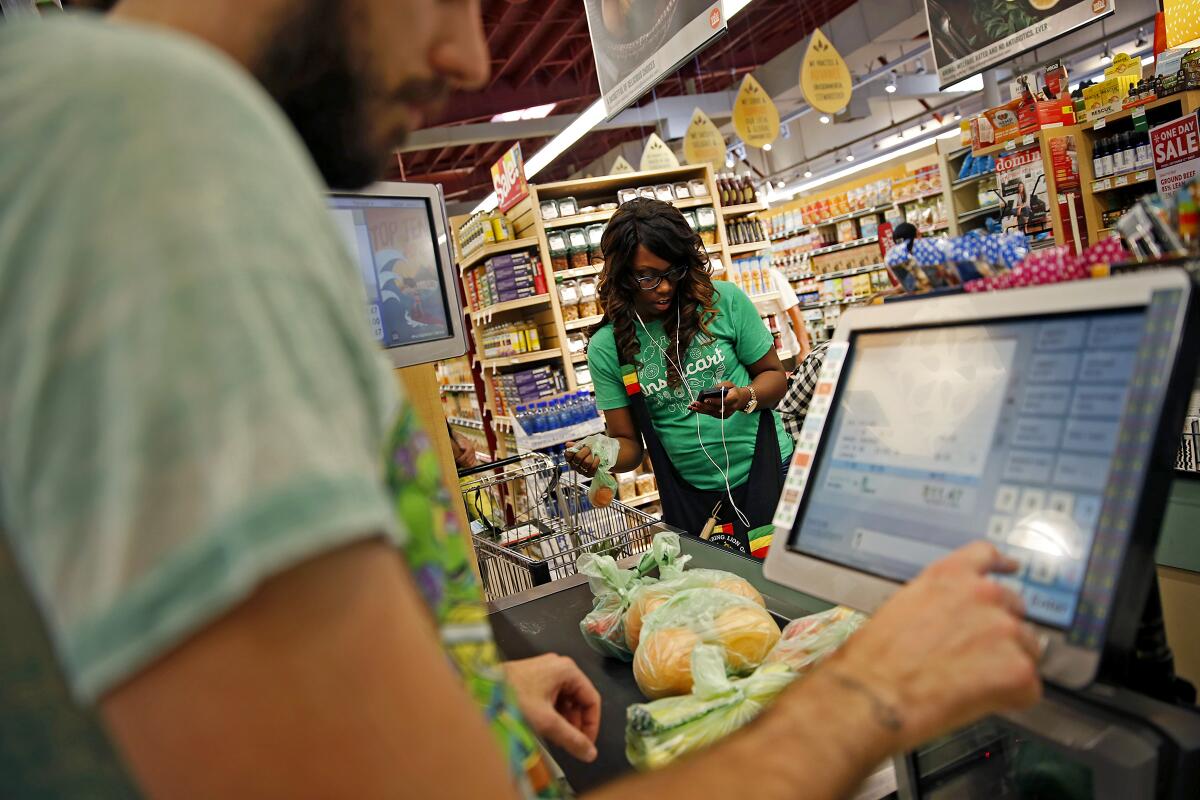The coronavirus crisis has been great for Instacart. For its workers, it’s a different story

Dina W. did her last job for Instacart on March 20. Before the coronavirus outbreak, Dina could easily avoid doing the labor-intensive orders that required her to shop for and deliver groceries to two or three customers at a time. But on that day, with few other choices, she accepted a triple order that promised take-home pay of $48. Only $17 of that was to be from Instacart, the rest in tips.
With shoppers in Delaware frantically preparing to hunker down in their homes, lines at the grocery store spanned the length of the building. Some items were nearly sold out; others carried limits on how many a customer could purchase at a time. Dina queued for more than 20 minutes at the deli, then again at the seafood counter. The line to check out lasted an hour. All the while, Dina was in constant communication with the three customers about what was unavailable and what they wanted instead.
Three hours of shopping later, she loaded 20 bags of groceries into her car and drove to the first customer’s home. On her way there, she got a notification: Customer No. 2, peeved at the long wait and unavailable items, had canceled the order. In the end, after about five hours of shopping and driving, Dina received $29.60, including tips, plus some of the groceries from the canceled order.
“It’s almost like you’re volunteering your time,” she said.
Since March 30, a contingent of Instacart workers across the country has been on strike over demands including hazard pay, protective gear and easier access to paid sick leave. The protest hasn’t made a dent in Instacart’s business. In fact, the company said it has seen an unprecedented number of grocery orders in the last few weeks.
For the people tasked with fulfilling those orders, that surge of demand has exacerbated long-standing stresses in their jobs and bolstered a critique that Instacart systematically exploits them with confusing, opaque and ever-changing practices. Navigating the wraparound lines and picked-over aisles of overtaxed supermarkets while balancing pandemic protocols, Instacart’s shoppers and drivers say they are risking their health and working longer hours than ever before, with little to show for it. Interviews with five drivers and documents that The Times reviewed reveal company policies that all but ensure extra demand doesn’t translate into higher pay for workers.
Among those policies is Instacart’s compensation model. A large part of shoppers’ pay is a 60-cent-per-mile fee for the distance driven between the store and the customer’s home. That component, which often makes up more than half of the pre-tip total, doesn’t reflect the size of the order or the time spent shopping, both of which have gone up dramatically since the arrival of the pandemic. If an order includes unusually heavy items, shoppers receive about $10 in extra pay. But, that applies only to the first 50 pounds. Customers are able to cancel orders right up until delivery. While Instacart still pays workers for those orders, they lose out on the tip, which often represents the majority of the total.
Company spokesperson Natalia Montalvo said Instacart shopper earnings increased 40% from February to March and tips have gone up 30%.
“In the last four weeks, Instacart has introduced more than 15 new product features, new health guidelines, new shopper bonuses, new sick leave policies and new safety supplies, as well as pay for those affected by COVID-19,” Montalvo said.
Instacart shoppers can choose from two kinds of orders: delivery only, meaning drivers pick up bags of groceries collected by someone else, and full service, which requires both shopping and delivery. Though some policies guarantee workers a minimum payment for each “full-service batch,” receipts show Instacart pays shoppers who complete multiple orders in one batch the same amount or just above what they are paid for a single order.
Some shoppers, such as Dina, avoid doing double- or triple-order batches because the logistics are too complicated, “and then the pay doesn’t add up,” she said. But avoiding them is difficult because it’s Instacart, not shoppers, that decides whether to aggregate orders, and with store access at a premium, the company has been bundling them more frequently.
Montalvo said that shoppers can choose whether to accept multi-order batches and that they often do since those orders are more “lucrative because they can earn tips for multiple orders with one trip to the grocery store.” Instacart guarantees a minimum of between $7 and $10 for full-service batches.
Montalvo said Instacart’s worker pay formula “takes into consideration the estimated time and effort involved in picking, packing and delivering a batch. This payment is dependent on a number of factors, including item quantity, weight, store type and distance.” But receipts The Times reviewed confirm Instacart pays shoppers about as much for multi-order batches as for single full-service orders despite the extra time and labor required.
A St. Louis, Mo., shopper provided receipts that showed Instacart offered $26.66 for a three-order batch totaling 72 items and requiring 11.2 miles of driving March 30. The company’s contribution to that pay was $12.76, less than half the total. The rest was in tips.
On the same day, Instacart offered the same shopper a total of $11.94 for a single order of 38 items requiring 3.9 miles of driving. Instacart’s contribution: $7.22. For buying nearly twice as many items and driving nearly three times as far, the company offered less than $6 extra out of its pocket. And this pattern holds in receipts The Times reviewed from around the country.
In essence, Instacart is getting shoppers to do more jobs and passing all or most of the extra labor cost on to customers in the form of tips. And tips aren’t guaranteed. With delivery slots at a premium, some customers have resorted to a practice known as “tip-baiting” — entering a large tip to secure an order, then withdrawing it after delivery.
“The core of this strike comes down to what Instacart is paying,” the St. Louis shopper said. “This isn’t about greed. It’s about ensuring the benefit is worth the cost.”
But the coronavirus crisis has also inflamed tensions over how Instacart responds to workers’ needs and feedback.
In the first few days of the strike, the company conceded to one of the workers’ demands, agreeing to provide sanitizer, masks and gloves free of charge. Previously the company did not provide any safety equipment. But supply has been limited and many shoppers have complained that they still haven’t been able to order the equipment.
When San Diego Instacart shopper Schana Cummings tried to order the safety kit on April 3, the app said it was “coming soon” and that sanitizer needed to be restocked, screenshots of the app show. Cummings tweeted about the lack of supply that day. On April 4, she received a notification in the app saying she was deactivated and to check her email. The email, which The Times reviewed, said that her application to be a shopper was denied. Cummings had worked for Instacart since 2018.
Instacart said Cummings was deactivated because she had two accounts — Cummings denies this and says she simply updated her email address on the same account in July 2019 — and said that shoppers “are given information on how to appeal directly with our Trust & Safety team” when they are deactivated. Emails and notifications that Cummings received and that The Times reviewed contained no such guidance. Montalvo said that the company “has never deactivated a shopper for posting feedback, criticism or opinions about the company on social media.”
Shoppers complain that it can take hours or days to get a response from the company on issues such as this. Montalvo said the dramatic growth in the ranks of both customers and workers has temporarily swelled wait times. “Overall customer order volume is up by more than 300% year over year, and we’ve also grown the shopper community from 200,000 to more than 350,000 in the last two weeks alone,” Montalvo said.
The slow response has been particularly difficult for shoppers such as Tom Andrew, who lives in San Diego. After Andrew was exposed to someone who tested positive for COVID-19, he began experiencing fevers, achiness and a dry cough. To request the two weeks of paid sick leave that Instacart promises to drivers diagnosed with COVID-19 or instructed to self-quarantine, he had his doctor complete an online form saying that “he has been in contact with someone with confirmed COVID-19 and therefore requires 14-day isolation.”
The company rejected his claim on the basis that he had not been diagnosed with COVID-19 himself or directed by a “public health agency” to quarantine. Questions about who qualifies as a public health official went unanswered, as did Andrew’s repeated attempts to point out that the form he filled out specifically asked if he’d been “directed by a qualified physician or public health authority” to quarantine. “My doctor IS a qualified physician is he not?” one of his emails, which The Times reviewed, read. Instacart’s customer support representatives did little beyond repeating their initial answer: “We carefully reviewed the documentation and, unfortunately, we were unable to confirm this claim at this time.”
Instacart’s policy requiring workers to provide documentation from a public health official to qualify for the paid sick leave differs from those of its competitors DoorDash and Uber, which say they accept doctors’ notes. The company says that’s because only local health authorities “are able to determine the necessity for quarantine based on confirmed cases of COVID-19.”
“Any individual who is diagnosed with COVID-19 is reported to the local public health authorities,” Montalvo said. “The local health authorities conduct contact tracing of any diagnosed individual to determine if any other parties have come into close contact to merit mandatory isolation or quarantine, regardless of their symptoms.”
It’s a high bar that workers are struggling to meet, according to the strike organizers. “Instacart knows it’s virtually impossible to meet their qualifications and is ignoring Shoppers’ pleas for more substantial and preventative help,” their blog post read.
Andrew still has not received any compensation. Cummings remains deactivated. As for Dina, after being on hold with customer support for two hours, she got the company to give her an extra $5. She doesn’t think she’ll go back to driving for Instacart unless it starts treating shoppers better.
“I’m not interested in these practices,” she said. “It’s too disrespectful to me.”







